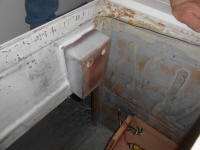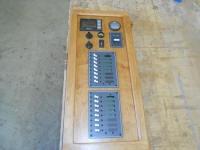
110 Cookson Lane | Whitefield, ME 04353 | 207-232-7600 | tim@lackeysailing.com
Snow Lily | Monday, March 18, 2013
I wanted to give the cabin sole finish a little time before I started dancing all over it, so I planned a variety of other tasks for the day that would keep be busy elsewhere on the boat, or in the shop. However, I removed all the masking tape from the sole, completing the finishing process.
In the cockpit, I prepared to install the molded recess enclosure for the throttle. After covering the area at hand with tape, I placed my cutout template in the position I wanted, then marked the cutout before cutting the opening with a jigsaw.
After checking the fit and drilling screw holes for the machine screws that would secure the enclosure, I installed the enclosure with sealant and bolts. I ran the throttle and key switch wires from the electrical locker aft to the enclosure's location, but would await final rewiring and installation till a little later, as I first wanted to do some locker painting in the area.




Now that the varnish work on the electrical panel door was complete, I could think about installing the components and moving on with the overall electrical installation. There was a variety of things I needed/wanted to install in this space, so to begin I covered the flat plywood panel with tape so I could lay out the locations of the components in the best way. Space was at a premium, but I thought fitting everything in would be no problem.
From the top down, I laid out for the components at hand, including a display monitor for the electric motor system, along with an attached alarm speaker; a battery monitor; USB charging ports and 12-volt accessory outlet; an inverter switch; AC shore power breaker; and two DC service panels, one each for 12- and 24-volt circuits.
Once happy with the layout, I made the cutouts as required and installed all the components.


It was time to think again about the interior locker doors, with an eye towards completing and hanging them soon. I like caned doors because they look interesting, are straightforward to build, strong, and, best of all, provide excellent ventilation to the lockers.
To begin, I measured the open portions of the doors and cut prewoven caning material to the appropriate size for most of the doors, leaving it a couple inches oversize in all dimensions. Then, starting with a stack of seven doors slated for the upper portions of the main cabin settees, I soaked the caning in water for an hour or so to make it pliable, and prepared to install the material.

It'd been quite some time since I'd built caned doors, probably about three years, so the first one was a re-learning experience. Once I'd completed the first door, the remaining six went much more quickly. The basic process was this: with the cane well soaked, I laid it out over the door and, in several steps, pressed the cane into the grooves around the door frame (which I'd milled much earlier) using wooden wedges, eventually pressing the caning all the way to the bottoms of the grooves. In the photo below, showing the first door, I show lots of wedges, but found that with the right technique I didn't need more than one to work my way around, as I became much more effective at working the caning into the grooves in the right way.

Then, using reed spline that I'd also soaked in water, I cut and installed the spline into the grooves to hold the caning in place, securing the splines with glue. I left the excess cane material for trimming later, once the glue had dried.



That was enough for one session, but in the coming days I'd continue the process on all the remaining doors.
To round out the day, I painted certain areas of the aft part of the boat, concentrating on areas where I needed to run wiring. Earlier in the day I'd installed wire tie mounts through these areas, since the adhesive used for the system didn't stick well to paint, and with those compete I could paint these areas to prepare for the work ahead. Eventually, I'd paint all the exposed hull in the cockpit lockers and beneath the cockpit, but didn't need or want to complete it all now.





Total Time on This Job Today: 8.25 hours





